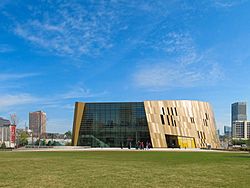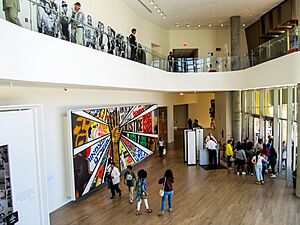National Center for Civil and Human Rights facts for kids
 |
|

The center in 2015
|
|
| Established | 23 June 2014 |
|---|---|
| Location | Atlanta, Georgia, USA |
| Collections | Papers and writings from Dr. Martin Luther King Jr. |
| Public transit access | Dome/GWCC (W1) or Civic Center (N2) (MARTA); Centennial Olympic Park (Atlanta Streetcar) |
| Nearest parking | Adjacent garages for Georgia Aquarium and World of Coca-Cola (pay) |
The National Center for Civil and Human Rights is a special museum in downtown Atlanta, Georgia. It teaches visitors about the amazing achievements of the civil rights movement in the United States. It also shows how people around the world have fought for human rights. The museum first opened its doors on June 23, 2014.
History of the Museum
How the Idea Started
The idea for this important museum came from several leaders. These included Evelyn G. Lowery, Juanita Abernathy, former Atlanta Mayor Andrew Young, and House Representative John Lewis. They were all part of the civil rights movement in the 1960s.
In 2001, Evelyn Lowery talked with Mayor Shirley Franklin. The mayor liked the idea of a museum honoring Atlanta's civil rights history. However, the city had money problems, so she could not help much at first. The group met again in 2005. This time, the mayor fully supported the project. The center was officially planned to be set up in 2007.
Designing and Building the Center
In 2009, five different architecture companies showed their ideas for the museum. The team chose a design by architect Philip Freelon. His plan was for a large museum, about 90,000 square feet (8,361 square meters). Construction was supposed to start in 2010 and finish by 2012.
The land for the museum was a gift from the Coca-Cola Company. It is about 2.5 acres (1 hectare) and is called Pemberton Place. This spot is next to popular places like the Georgia Aquarium, the World of Coca-Cola, and Centennial Olympic Park.
Challenges and Opening
Building the museum faced some delays. A big economic downturn, called the Great Recession, made it harder to raise money. Support from companies like Delta Air Lines and people like Atlanta Falcons owner Arthur Blank was slow to come. Each of them gave $1 million to help.
In October 2010, the museum's leader, Doug Shipman, announced a delay. The museum would open a year later, in 2013. In March 2011, the plans were changed to make the museum a bit smaller. Its size was reduced to 63,000 square feet (5,853 square meters). But the space for exhibits stayed the same, at 30,000 square feet (2,787 square meters).
In December 2011, the museum decided to build in three stages. The first part, about 35,000 square feet (3,251 square meters), would start in June 2012. It was planned to open by Memorial Day in 2014. This change was partly to make sure they did not lose $28.5 million in special funds.
The groundbreaking ceremony finally happened on June 27, 2012. Many important people attended, including Atlanta Mayor Kasim Reed and former mayors Franklin and Young. The museum officially opened to the public on June 23, 2014.
In January 2019, Jill Savitt became the new CEO of the center. She had worked at the United States Holocaust Memorial Museum before joining.
Museum Exhibits
The center has many exhibits, both permanent and temporary. These exhibits tell the story of the civil rights movement in the United States. They also show how those struggles connect to human rights issues around the world today. The museum has three main permanent exhibits. Visitors can usually see them all in about 75 minutes.
Voice to the Voiceless: The Martin Luther King, Jr. Collection
This exhibit features personal items that belonged to Dr. Martin Luther King Jr.. The collection was bought in 2006. Atlanta's mayor helped buy these important letters and papers for $32 million. Morehouse College owns the collection, and the center has the right to display it.
This exhibit tells Dr. King's life story. It starts from his childhood and goes through to his assassination. It includes important writings like drafts of his "Letter from Birmingham Jail" and a sermon called "Drum Major Instinct."
Rolls Down Like Water: The American Civil Rights Movement
This is an exciting, interactive exhibit. It begins by showing examples of segregation in the United States. This includes Jim Crow laws and "whites only" signs. The exhibit was designed by George C. Wolfe, a famous playwright.
The gallery is divided into sections, each focusing on a key event. One example is Brown vs. Board of Education, a major court case. Many parts of this exhibit are interactive. You can even sit at a recreated lunch counter sit-in. Headphones let you hear the sounds and threats that activists faced during those times.
Spark of Conviction: The Global Human Rights Movement
This exhibit is different because it does not follow a straight timeline. It shows images of leaders who caused great harm in history. But it also highlights modern-day activists. These activists work to make things better for women and LGBT individuals around the world.
One activity in this exhibit is called "Who Like Me." Visitors can choose a trait, like their religion or gender. The exhibit then shows them a person from another country who is treated unfairly because of that same trait.
Building Design
The design for the center was created by architect Philip Freelon. He worked with the company HOK to bring the building to life.
See also


